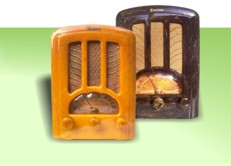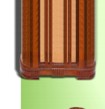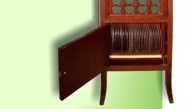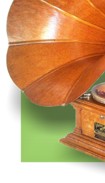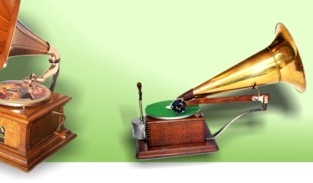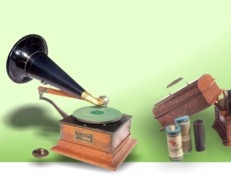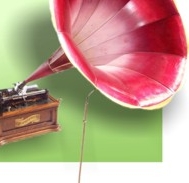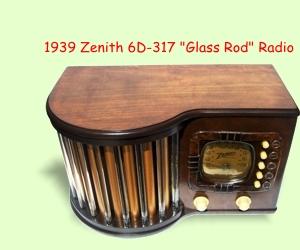|
In a Nutshell
FADA Fadalette 106 built in 1933 at the peak of the Great Depression, last serviced in 1937 by Radio Doctor Glen Ellen Bowlsbey from Oakland, California

Introduction:
My radio strongly reminds us Coronavirus stricken stay-home people of what can happen in or after an economic depression like the one to come. The radio was produced in 1933, that is in the worst year of the Great Depression, that lasted from October 1929 to World War II (see historians below). Very likely a family from Oakland, California listened through this radio to newly elected president F. D. Roosevelt's first inauguration speech (ref.1) on March 4, 1933 and to his subsequent "Fireside Chats" (ref.2). They treasured their radio and had it last serviced in 1937 by the Radio Doctor. The radio was made by Frank A. D. Andrea (refs.3,4) [1888 - 1965], who had immigrated in 1890, two years old with his mother from Italy. He got acquainted with Dr. Lee DeForest, the inventor of the Audion vacuum tube, and with Guglielmo Marconi. After having achieved his goal of getting rich, Frank Andrea sold the company in 1932, but soon after started again, this time with TV sets and entertainment consoles. His prewar and postwar catalin table radios are the highest paid collector radios today.
Despite, or perhaps because of the depression the 1930's were the "Golden Age of Radio". In 1925 Canadian Edward Samuel Rogers (Ted Rogers Sr., [1900-1939]) had made the radio running on ordinary AC household current, in 1931 Philco started to produce "midget" (today's "cathedral") radios - table radios, to set them apart from console radios, which were the norm until then, and based on the new Superheterodyne principle released by RCA ("Licensed under patents of The Radio Corporation of America"). Radio transformed into the internet of the 1930's. In 1933 about 60% of US households had at least one radio, 66% had short-wave capability, and 75% were table models. Radio was the source of news about the economy, the drought, jobs, store sales, etc. and provided distraction from hard times in the form of music, variety, adventure, comedy, soap operas, and sponsored advertising shows, like Amos 'n' Andy, The Lone Ranger, Little Orphan Annie. Demand was highest for low cost, high performance and affordable radios.
The FADA Superfadalette is a 2-band miniature receiver in a gold-embossed art-leather (leatherette) covered wooden cabinet, and came in four colors (burgundy red, ivory,
deep green,
Spanish brown). The chassis is in fact anything but cheap, " ... 7-tube performance in a 5-tube set" (pict.28), all of which had just been developed. The radio has AVC (Automatic Volume Control), a long dipole antenna, and a resistive (175 Ohm) "curtain burner" line cord (pict.21), that dissipates half of the heat (30 Watt) outside the radio. The 1933 sales price was $25 (today $500), almost three times less than a Philco 90 cathedral radio - and about the same as the German Volksempfänger VE301 introduced by Hitler and Goebbels on August 18 the same year 1933, as a Nazi propaganda instrument. Both radios were extremely popular at the time in their respective countries.
Additional information:
ref.1: https://www.historyplace.com/speeches/fdr-first-inaug.htm
ref.2: http://historymatters.gmu.edu/d/8126
ref.3: http://www.andreaelectronics.com/wp-content/uploads/2015/07/Distant-Sparks.pdf
ref.4: http://classicradiogallery.com/fada_history.html
ref.5: https://youtu.be/LpWScP0N-ng
About my Radio:
My radio is the most attractive (pict.30) Spanish brown version with all parts (knobs, antenna, resistive line cord, 5" field coil speaker, speaker cloth) being original. It was serviced on Jan. 28, 1937 by the Radio Doctor Glen Ellen Bowlsbey in Fruitvale, Oakland, 1510 Hopkins St., at 14th Ave. (picts.24,25). His phone number 6170 can still be verified in the phone book (pict.26). Hopkins Street was renamed after General Douglas MacArthur as MacArthur Blvd. in 1942 (pict.27). My radio is recapped with new electrolytic capacitors hidden in the original shell (picts.15,16). I installed a 3.5mm closed circuit phone adapter to play other devices like ipods, mp3 players and cellphones. Don't miss the youtube video (ref.5) by clicking on thumbnail 32 below. Please
e-mail me (Kris) for any questions, ich spreche Deutsch, je parle Français.
For the history buffs only:
The present COVID-19 outbreak prompts comparisons with other world-wide disasters, like world wars, pandemics and financial meltdowns, the most severe ones being WWI/II (~80 million deaths combined), the 1918 Spanish flu pandemic (~50 million deaths), and the 1930's Great Depression (unemployment rate ~30%), respectively. The stock market crash happened on October 24, 1929 (Black Thursday), caused mainly by a long period of rising market growth that led to consumer overconfidence and overproduction by industries such as manufacturing and agriculture including farm crops, steel, durable goods and iron. People rushed to their banks to withdraw their funds, but the money was invested in these markets (Washington Post of Oct. 23: "Huge Selling Wave Creates Near-Panic as Stocks Collapse"). It took 3 years to reach the bottom, and in 1933 stocks had lost 80% and half the American banks had failed. One time Republican President Herbert Hoover (Inaugural address March 4, 1929: "I have no fears for the future of our country. It is bright with hope") had a laissez-faire approach to the depression, encouraging "rugged individualism" of the US states vs. involving government in relief efforts. He introduced tax cuts for the rich, failing tariff policies, causing retaliations, and committed to "volunteerism" to provide public assistance. Sounds familiar? Hoover in the Presidential campaign of 1932 was challenged by Democratic nominee Franklin Delano Roosevelt (F.D.R.). He proposed positive, energetic, and imaginative initiatives, promising the American people a "New Deal". He easily won the election with almost sixty percent of the popular vote. In his First Inaugural Address of March 4, 1933, he stated (ref.2): " ... So, first of all, let me assert my firm belief that the only thing we have to fear is fear itself - nameless, unreasoning, unjustified terror which paralyzes needed efforts to convert retreat into advance. ... More important, a host of unemployed citizens face the grim problem of existence, and an equally great number toil with little return. Only a foolish optimist can deny the dark realities of the moment. ...". In the first hundred days of his new administration he tried to provide immediate relief, short-term recovery, and long-term reform. Although recovery of the economy was far from healthy after four years, Roosevelt again won over sixty percent of the popular vote in the 1936 Presidential Election.
F.D.R. made good use of the radio, which was getting a major industry in the 1930's and one of the earliest to recover, by broadcasting 31 "Fireside Chats" from the White House Diplomatic Room - which has no fireplace - , starting on March 12, 1933, explaining to the panicked public the major events of the time and his response to them in a calm, comforting and reassuring voice. He got 50,000 fan mail letters a week from listeners (ref.2), beating his predecessor by a factor of 10. How much more convincing was that than today's use of the radio's replacement Twitter, Instagram and all that? And how does it compare with the present chaos in the White House, with its five uncoordinated task forces, purported "woodoo" in the Situation Room, and the ingratiating and tiring daily press briefings by a president who considers them as essential part of his re-election campaign?
|



